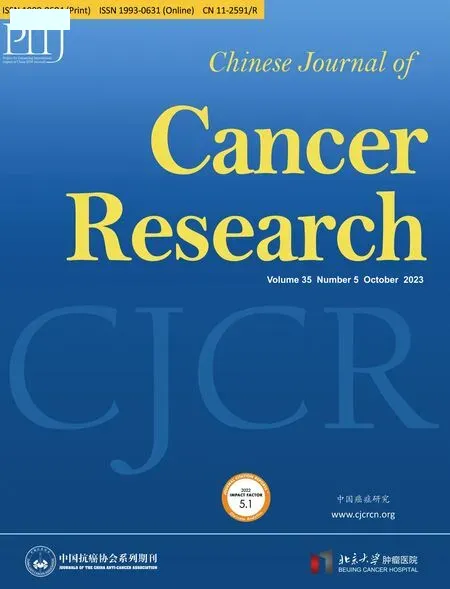Comments on National Health Commission guidelines for diagnosis and treatment of colorectal cancer 2023 in China(English version)
Yong Yang ,Zhaoya Gao ,Jin Gu,2
1Department of Gastrointestinal Surgery,Peking University Shougang Hospital,Beijing 100144,China;2Key Laboratory of Carcinogenesis and Translational Research (Ministry of Education/Beijing),Gastrointestinal Cancer Center,Peking University Cancer Hospital &Institute,Beijing 100142,China
Colorectal cancer (CRC) has always been one of the most common malignant tumors in the world,and the incidence and mortality have been on the rise in China.The Cancer Statistics Report of China in 2020 showed that the incidence and mortality of CRC ranked second and fifth among all malignant tumors,with 555,000 new cases and 286,000 deaths,respectively.Among them,cities were much higher than rural areas,and the incidence of colon cancer had increased significantly.Most patients were already in the advanced stage at the time of diagnosis.
According to the experience of those countries where the incidence is gradually declining,such as the United States and some European countries,early screening and standardized diagnosis and treatment are effective ways to control CRC.However,government-led early screening is limited to some developed cities,and nationwide CRC screening has not been performed yet.In addition,medical resources are not balanced,and the level of diagnosis and treatment of doctors is uneven among different regions,there is even a lack of specialist.
Since 2010,the National Health Commission and the Oncology Branch of the Chinese Medical Association have organized domestic authoritative experts to compile guidelines for the diagnosis and treatment of CRC,aiming to improve the level of the diagnosis and treatment of CRC in China (1).TheNational Health Commission guidelines for diagnosis and treatment of colorectal cancer 2023 in China(English version)(2) was updated and released by the National Health Commission of the People’s Republic of China based on the 2020 edition.Besides inheriting the main model of the previous version,it has been updated based on the progress of diagnosis and treatment in recent years.Some of the contents have been rewritten,making the new guidelines more focused,concise and practical.
In the Diagnosis chapter.The importance of magnetic resonance imaging (MRI) in diagnosis and treatment of CRC is emphasized again,and its application in clinical staging of low rectal cancer,efficacy evaluation after neoadjuvant treatment and special type of rectal cancer are detailed.Tumor budding is closely related to vascular invasion,nerve invasion and immune score,and is an important indicator to judge the prognosis and evaluate the efficacy of adjuvant therapy.And it is recommended to report tumor budding grade in surgical pathology.In addition,for early-stage CRC,the detection ofKRAS,NRAS,andBRAFgene mutations is recommended to assess the prognosis and recurrence risk.
In the Surgical Treatment chapter.For early-stage CRC after local resection,additional colorectal resection and regional lymph node dissection are recommended in the following cases: 1) Histological features with poor prognosis,such as poor differentiation (poorly differentiated adenocarcinoma,undifferentiated carcinoma,signet-ring cell carcinoma,mucinous adenocarcinoma,etc.)and vascular infiltration;2) Non-complete resection,specimen fragmentation,and resection margins could not be evaluated;3) The depth of submucosal invasion ≥1,000 μm;4) Positive resection margin (tumors present within 1 mm from the resection margin or tumor cells visible from the electric cutting edge);and 5) Tumor budding in G2/G3.For famililial adenomatous polyposis,total colorectal resection and ileal storage bag anal anastomosis,and total colorectal resection and ileorectal anastomosis are recommended (the anastomosis is recommended within 7 cm from the anal margin for later follow-up).If cancer occurs,the corresponding operation will be performed according to the site of cancer.Robotic-assisted CRC resection can be carried out in centers where conditions permit,and NOSES surgery can be carried out under the condition of strictly mastering the indications.
In the Medical Treatment and Radiotherapy chapter.Mismatch repair (MMR) or microsatellite instability (MSI)testing is recommended for the preoperative treatment of rectal cancer.Foreign studies show a high response rate to PD-1 antibody with MMR-deficient or MSI-high (MSIH),so we can consider deciding whether to perform neoadjuvant immunotherapy under the guidance of a multidisciplinary team.For an NTRK fusion variant,NTRK inhibitor treatment is recommended after standard treatment failure.The evaluation time of clinical complete response is recommended 8-12 weeks after concurrent chemoradiotherapy,and is extended to 16-24 weeks as appropriate for patients receiving interval consolidation chemotherapy or total neoadjuvant therapy.Follow-up every 2-3 months for 2 years is recommended,and the frequency of follow-up refers to the postoperative patients.In addition,a combination regimen of capecitabine and irinotecan is added during long-course radiotherapy in this version.Combined with the risk of recurrence evaluated by MRI,preoperative neoadjuvant chemoradiotherapy(NCRT) rather than postoperative radiotherapy is recommended.For patients with metastasis of lateral lymph nodes,lateral lymph nodes is recommended to retreat after neoadjuvant radiotherapy,according to the case;if lateral lymph nodes cannot be performed for various reasons,there is no high-level evidence-based medical evidence to support,and additional radiotherapy to the metastatic lateral lymph nodes can be considered during NCRT.
In general,although the 5-year over survival rate of CRC in China still lags behind compared with the United States,clinicians and researchers have been committed to improving the survival rate and quality of life of patients.The new version of the guidelines once again demonstrates the determination and efforts of Chinese scholars in overcoming the difficulties of CRC.It is anticipated that our work will help to overcome the malignancy and ultimately benefit the patients and their families.
Acknowledgements
None.
Footnote
Conflicts of Interest: The authors have no conflicts of interest to declare.
 Chinese Journal of Cancer Research2023年5期
Chinese Journal of Cancer Research2023年5期
- Chinese Journal of Cancer Research的其它文章
- OpenNAU: An open-source platform for normalizing,analyzing,and visualizing cancer untargeted metabolomics data
- Genetic abnormalities assist in pathological diagnosis and EBVpositive cell density impact survival in Chinese angioimmunoblastic T-cell lymphoma patients
- Baseline radiologic features as predictors of efficacy in patients with pancreatic neuroendocrine tumors with liver metastases receiving surufatinib
- A novel multimodal prediction model based on DNA methylation biomarkers and low-dose computed tomography images for identifying early-stage lung cancer
- Genetic susceptibility loci of lung cancer are associated with malignant risk of pulmonary nodules and improve malignancy diagnosis based on CEA levels
- Update of latest data for combined therapy for esophageal cancer using radiotherapy and immunotherapy: A focus on efficacy,safety,and biomarkers
